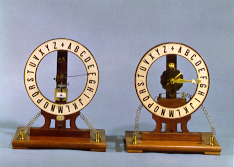
39.1 x 24.3 x 38.7
Copper, brass, wood, ivory and paper
CAT. 1878 : 531
Modelo do telegrapho electrico de Bréguet.
Model of the Bréguet electrical telegraph.
One of Mankind's greatest preoccupations throughout its history has been to devise means to send messages over long distances.
The first attempts to use electricity in communication systems were made in the 18th century. Lesage conducted an experiment in Coimbra in 1774 that consisted of using twenty-four metal wires which exercised an electrical influence on the same number of electroscopes of a pendulum, each of which corresponded to a letter of the alphabet. Another device, developed in Spain, used Leyden jars. In 1811, new attempts at long-distance communication were made using a system of voltameters. This comprised thirty-six metal wires with gold needles at their ends, submerged in acidulated water.
Following Ampère's discoveries in 1820 and the construction of the first electromagnet, there was a new surge of interest in developing new means of communication.
Bréguet's telegraph, consisting of a transmitter and a receiver supplied by an electric battery, is one example of the new technology. Both transmitter and receiver have a round face on which appear the letters of the alphabet. In the centre of the transmitter's dial is a wavy-edged brass disc. When this disc is turned it activates a metal tongue which alternately closes and opens the electric circuit formed by the transmitter, receiver and electric battery. The receiver has an electromagnet which acts on an armature, attracting it when the transmitter's tongue closes the electrical circuit and releasing it when the circuit is open. The shuttle movement of the armature is transmitted to a toothed wheel; this turns in unison with a pointer whose tip thereby indicates the letters of the alphabet on the receiver dial.
At the beginning of the message, the pointers of the transmitter and receiver point to a cross on the respective dials. When the person using the transmitter turns the pointer, the electrical circuit opens and closes successively, and the pointer on the receiver advances to the letter corresponding to the position where the transmitter pointer stops. Once the first letter is received, the operators of the receiver and the transmitter should put the pointers back to the initial position. This process is repeated for each letter of the message.
The model in the Gabinete de Física was acquired in 1869.
Daguin, Pierre-Adolphe, Traité Élémentaire de Physique Théorique et Expérimentale, Paris, 1867, n.º 1827.